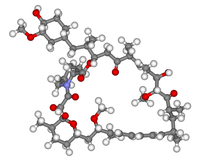
Photo from wikipedia
Dietary n-3 polyunsaturated fatty acids (n-3 PUFAs) increase insulin signaling in skeletal muscle. In the current study, we investigated the effect of eicosapentaenoic acid (EPA) on insulin-induced mammalian target of… Click to show full abstract
Dietary n-3 polyunsaturated fatty acids (n-3 PUFAs) increase insulin signaling in skeletal muscle. In the current study, we investigated the effect of eicosapentaenoic acid (EPA) on insulin-induced mammalian target of rapamycin (mTOR) phosphorylation in myotubes. We showed that EPA did not affect basal and insulin-induced mTOR phosphorylation in myotubes. However, EPA abolished lipopolysaccharide (LPS) -induced deficiency in insulin signaling (P < 0.05). Pre-incubation of nuclear factor κB (NF-κΒ) and c-Jun N-terminal kinases (JNK) inhibitors prevented the decreased insulin-induced mTOR phosphorylation elicited by LPS (P < 0.05). In addition, in protein tyrosine phosphatase-1B (PTP1B) knockdown myotubes, LPS failed to decrease insulin-induced mammalian target of rapamycin (mTOR) phosphorylation in myotubes (P > 0.05). In myotubes, LPS stimulated PTP1B expression via NF-κB and activation protein-1 (AP1). Pre-incubation of 50 μM EPA prevented the LPS-induced activation of AP1 and NF-κΒ as well as PTP1B expression (P < 0.05). Interestingly, incubation of peroxisome proliferator-activated receptor γ (PPARγ) antagonist (GW9662) prior to EPA treatment, the effect of EPA on insulin-induced mTOR phosphorylation was blocked. Accordingly, EPA did not inhibit the LPS-induced activation of AP1 or NF-κΒ as well as PTP1B expression when incubation of GW9662 prior to EPA treatment. The in vivo study showed that EPA prevented LPS-induced PTPT1B expression and a decrease in insulin-induced mTOR phosphorylation in muscle of mice. In summary, EPA abolished LPS inhibition of insulin-induced mTOR phosphorylation in myotubes, and one of the key mechanisms was to inhibit AP1 and NF-κB activation and PTP1B transcription.
Journal Title: Molecular and Cellular Endocrinology
Year Published: 2017
Link to full text (if available)
Share on Social Media: Sign Up to like & get
recommendations!